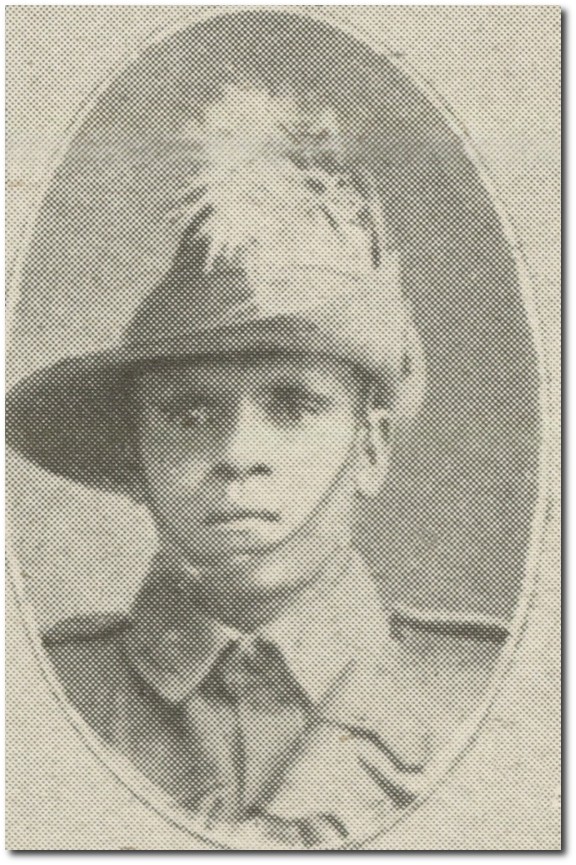
Portrait of Arthur Murdock, published in The Queenslander Pictorial, 7 April 1917
Indigenous Australian, Arthur Murdock, 41st Infantry Battalion
Arthur Murdock was born in Hughenden, Qld. about 1898 to Arthur Murdock and Zoe Button. He was working as a stockman on Antrim Station, Tangorin south of Hughenden, when he volunteered to serve with the first AIF in October 1916
Murdock initially trained in Enoggera at Bell's Paddock Camp, having been allotted to the 7th Machine Gun Company, but was later attached to the Light Horse Regiment at Lytton Camp. His skills as a horseman would certainly have been highly valued, but in June 1917 he was selected to serve as an Infantry man with the 41st Battalion and left Sydney on board the troopship Horarata bound for England.
Murdock was taken ill during the voyage and admitted to the ships hospital with mumps, which commonly spread among such large groups of men confined to a ship for up to six weeks. When they arrived in Liverpool the men were housed in an 'isolation camp' at Larkhill Barracks, to prevent any further spread of infectious diseases. Murdock was caught outside the ward and fined for his misdemeanor '7 days field punishment no.2' - confined to barracks for another week.
The 8th Reinforcements landed in France early in February 1918 where they camped for a few days before moving out to join the Battalion in the field. At this time the 41st was deployed at Pont Rouge, south of Ypres. The next month the battalion moved south to Amiens, during the March 1918 German offensive.
Arthur Murdock was wounded in the thigh, on 27 August 1918 while the battalion was operating near Maricourt, in the Somme Valley. Murdock was evacuated to the 1st Southern General Hospital, Birmingham, England where his leg was operated on and he spent the remainder of 1918 recuperating before being repatriated home to Australia in December, on board the Mamari and discharged medically unfit for any further service.
Arthur returned to the mission at Barambah and married Daisy Collins from Clermont in May 1919, one of the Wangan and Jagalingou people. Still recovering from his wound, Arthur was unable to immediately take up his former employment as a stockman on Antrim Station. He was later employed for two years at Stonehenge, Queensland as a police tracker, but was removed to Palm Island in 1928.
In the 1930's there are articles items in the newspapers of the day of Arthur Murdock featuring in buck-jumping exhibitions in Cairns and Hughenden, and in 1943 the Queensland Electoral Roll lists him as working on Wongallee Station, Hughenden.
Eventually Arthur's damaged leg hampered his ability to work as a stockman, no longer able to mount a horse, he gained employment with the Queensland Railways as a labourer.
Arthur Murdock had 5 children, the eldest George Henry Murdock featured in many Australian films often playing the part of his other working life - a stockman.
Arthur Murdock was a proud Australian who raised the flag at the Anzac Day service on Palm Island in 1936 where he had been appointed Sergeant of the Native Police. He was a member of the RSL in Townsville in 1941 and later the Australian Legion of Ex-Servicemen and Women in Brisbane. He died of heart failure in 1965 at Clermont, where he is buried.
Read more ...
- Service record: MURDOCK, Arthur
- Embarkation roll: 8th Reinf. 41st Infantry Battalion
- AIF Unit diaries: 41st Infantry Battalion
- Repatriation record: MURDOCK, Arthur
- 'News in brief', The Courier-Mail 4 May 1936, p13
- 'Roughriders in Cairns' Cairns Post, 29 July 1939, p.8
- 'On the track', Townsville Daily Bulletin, 25 September 1945, p5
- Koa People
- Aboriginal Trackers Records
- Queensland Removals 1928
- Andrew Walker and Jonathan Richards, 'Murdock, George Henry (1920–1987)', Australian Dictionary of Biography, National Centre of Biography, Australian National University
- One of the soldiers featured in SLQ’s HistoryPin Collection
- Queensland’s Indigenous Servicemen [digital story & oral history, 12 mins, mp4]
The information in this blog post has been researched by State Library staff and volunteers, it is based on available information at this time. If you have more information that you would like to share or further research uncovers new findings, this post will be updated.
Comments
Your email address will not be published.
We welcome relevant, respectful comments.